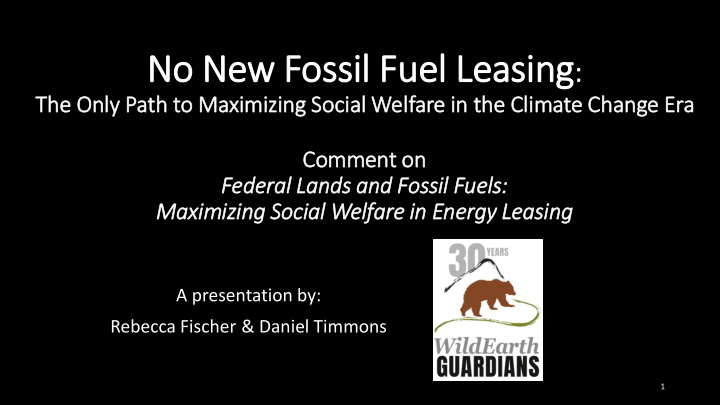



No New Fossil Fuel Leasing : Th The Only ly Path th to Maxi ximizing So Social Welf lfare in in th the Clim limate Change Era Comment on Federal Lands and Fossil Fuels: Maxim imizing Social Welf lfare in in Energy Leasing A presentation by: Rebecca Fischer & Daniel Timmons 1
Outline of Argument • Professor Hein: • DOI has a duty to consider public welfare in its federal energy leasing program • DOI can meet this duty by increasing royalty rates, bonus bids, rental rates for federal fossil fuel leasing, etc. • Our Response: • The current climate crisis requires much more than marginal changes to royalty rates and the leasing process. • If DOI was to truly consider public welfare and account for the current climate crisis in its decisions, it would recognize that no new fossil fuel leasing could be allowed on federal lands. 2
Professor Hein’s Proposed Reforms • Programmatic review of federal fossil fuel leasing • Last one done on coal in the 1980s • Never been done for onshore oil and gas • Royalty rate adjustments w. SCC • NEPA alternatives • Eliminate royalty rate reductions and loopholes • Reform leasing to promote competition 3
The Realities of the Current Climate Crisis US GHG Federal Public Lands GHG Future Federal Public Emissions in Emissions in 2014 Lands GHG Emissions 2013 6.67 Gt CO2e 1.33 Gt CO2e (20%) 30 to 43 Gt CO2e Sources: EcoShift Report USGS, Federal Lands Greenhouse Gas Emissions and Sequestration in the United States: Estimates for 2005-14 4
GHG Emissions from Federal Public Lands Are Significant 5 Image credit: The Wilderness Society
The Concept of Carbon Budgeting • IPCC Fourth Assessment sets global carbon limit • From this, we can extrapolate a US carbon budget • NOTE: this is out of date now that warming must be limited to 1.5°C Source: EcoShift Report
The More We Delay, the Smaller the World’s Carbon Budget Gets Source: 2016 Oil Change International Report 7
2018 IPCC Special Report : We Must Limit Warming to 1.5°C • Big differences in the impacts between 1.5° and 2°C of warming • 10 million people more exposed to flooding from sea level rise • Several million more people susceptible to poverty • Death of 99% of coral reefs • Must limit warming to 1.5C° • “The world has 12 years to cut global greenhouse gas emissions by 45% from 2010 levels and must zero out emissions by 2050 in order to limit warming to 1.5°C .” • Note: already experienced approx. warming of 1°C above pre- industrial levels 8
Under Revised Carbon Budget, Existing World Reserves Far Exceed Limits Source: 2019 Oil Change International Report 9
What Does this Mean for the US? • To conform to a 1.5°C target, the estimated U.S. carbon budget is 57 GtCO 2 eq on average. • Already leased federal fossil fuels if fully extracted and burned = 30 to 43 GtCO 2 e (50-75% of the budget). • NOTE: this does not account for state/private development Sources: Robiou du Pont et al. EcoShift Report 10
Need for an Honest Accounting • Premise 1: Global environmental, economic, and social catastrophe projected at warming above 1.5 C; • Premise 2: Already committed fossil fuel resources exceed total U.S. carbon budget; • Conclusion: All future federal fossil fuel leasing must end to meet 1.5 C • Therefore, the social cost of any new federal fossil fuel leasing must exceed the economic value of extracted fossil fuels (or at least be set high enough to pay for 100% carbon offset elsewhere). 11
Accounting for the Social Costs of Carbon • Interagency Working Group: $11 - $105 per ton; $42 per ton median value • BLM’s September 2018 lease sale in New Mexico’s Permian Basin generated nearly a billion dollars in bid payments • Social cost of carbon from downstream emissions ranges from $2.5 billion to $23.6 billion; median value of $13.1 billion 12
But Can Interior Do the Math? • Past Practice Shows Pattern of Ignoring Costs of Carbon • Agency Consistently Views Lease Sales and Drilling Permits in Isolation • Regulatory Capture by Oil and Gas Industry • Can we really trust Interior staff to finally take an honest, hard look at the social costs of its oil and gas program without a top- down mandate? 13
Conclusion 14
Recommend
More recommend